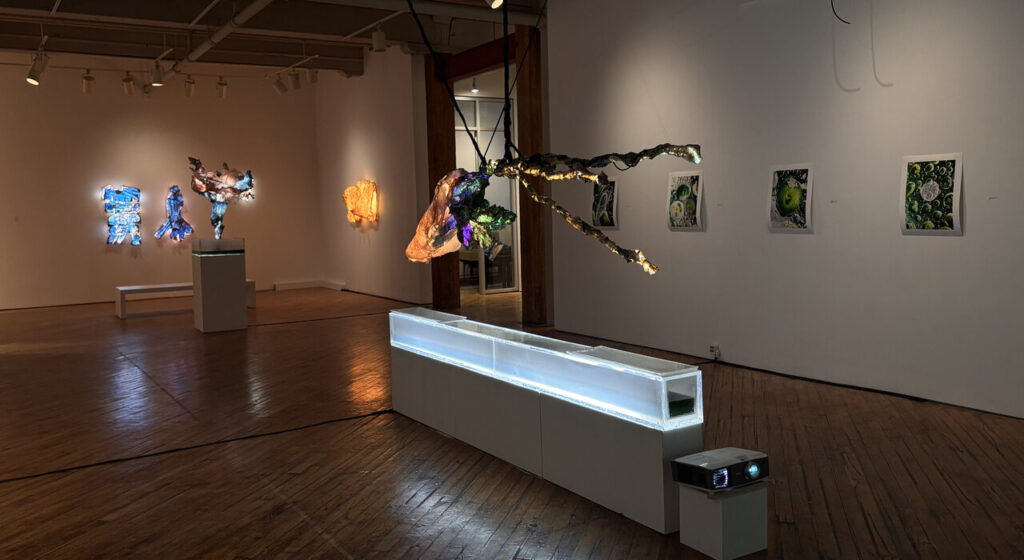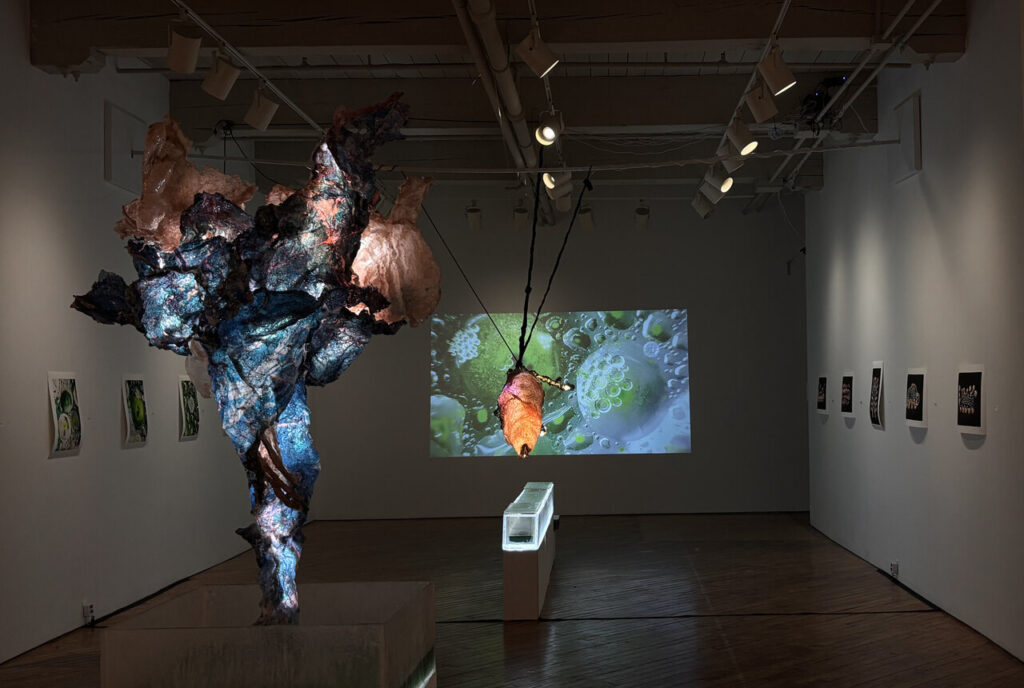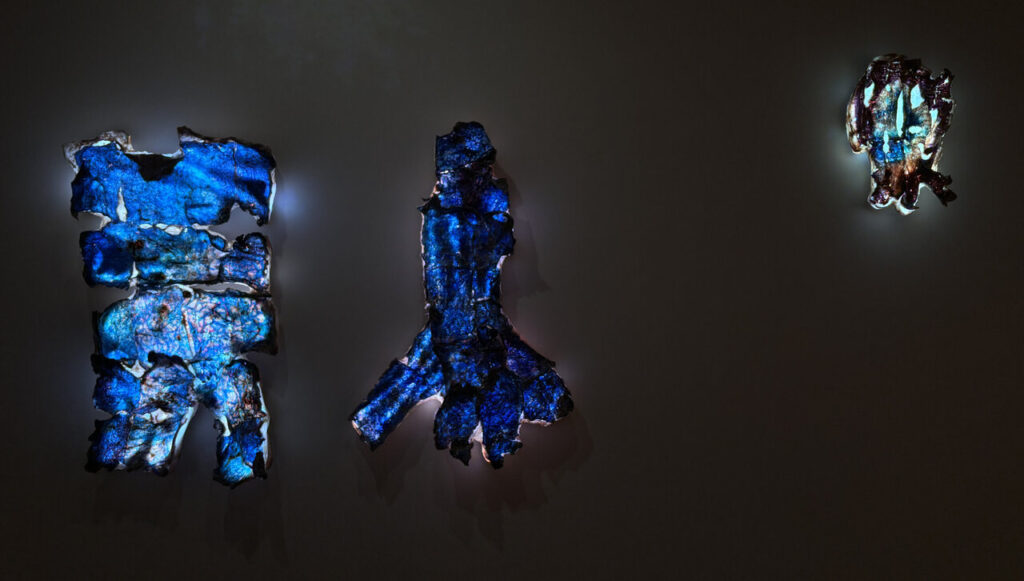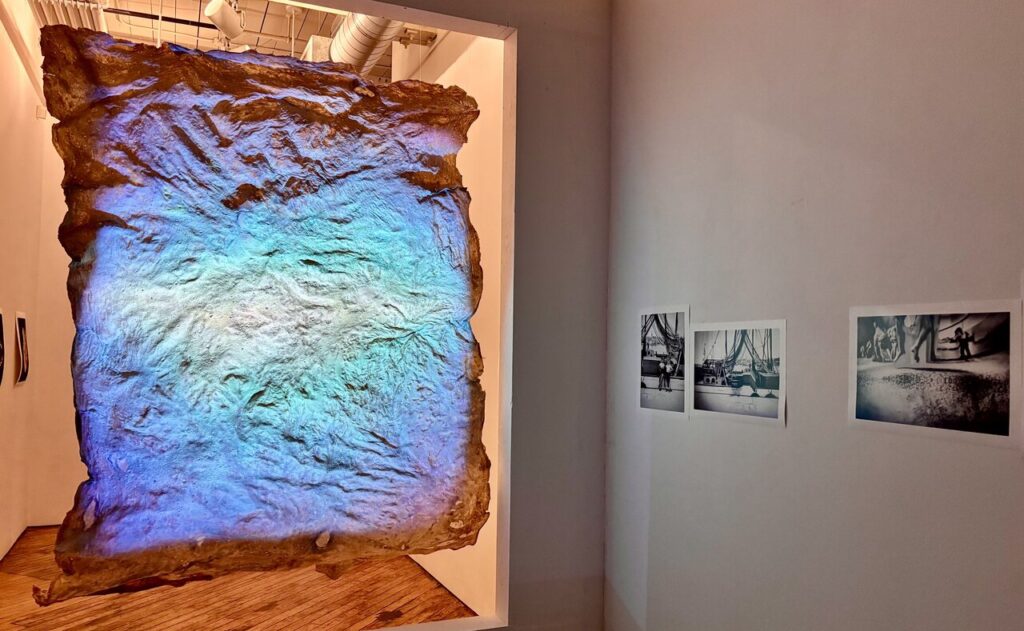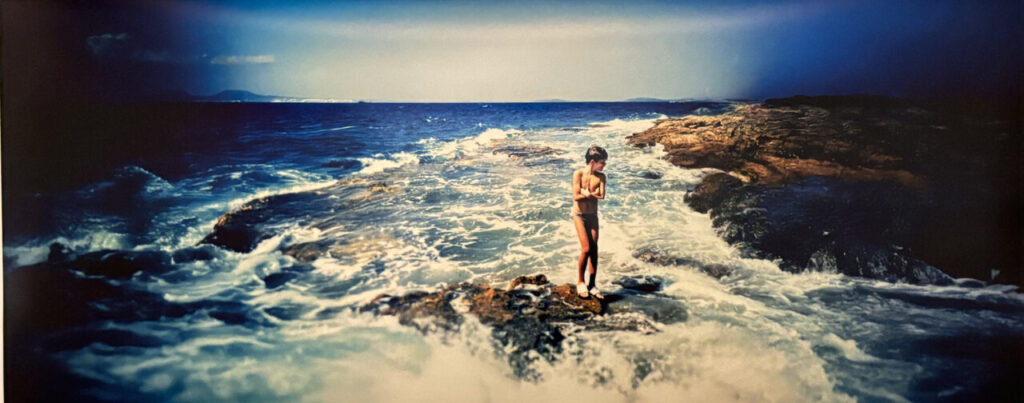Vladimir Kanic’s Garden of Hope exhibition at the Abbozzo Gallery presents a captivating blend of living art, environmental consciousness, and personal narrative. The exhibition highlights Kanic’s innovative approach to creation by using sustainable natural materials in his work. Kanic’s use of this concept has become increasingly significant as we continue to address nature and climate issues that have prominently influenced politics since the 1980s. Kanic raises awareness about climate issues through his work, believing that it can spark conversations about life, technology, ecology, and the future of art. In this way, his mixed media and algae biopolymer-based sculptures serve as a symbol of hope for change.
Installation view of Vladimir Kanic, Garden of Hope at the Abbazzo Gallery, 2025 with LACE (Living Algae Cyborg Ecosystem), 2025, Algae Biopolymers/Living Algae Culture, 25 x 108 inches
The artist uses dried algae biomass as well as living algae as a sculptural medium, allowing him to transform “waste” into art. Kanic actively contributes to environmentally friendly initiatives by incorporating a liquid blend of algae and spirulina into the composition of LACE (Living Algae Cyborg Ecosystem) (2025) and Book of Waves pt. 200 (2023), sculptures that help to remove carbon dioxide from the air. These living sculptures interact with the breath of spectators, transforming it into oxygen and creating an immersive environment. Through this procedure the sculpture changes shape and its colors deepen.
Vladimir Kanic, Book of Waves pt. 200, 2023, Algae Biopolymers/Living Algae Culture, 92 x 21 x 21 inches (left)
Additionally, through these sustainable works, the artist not only sets an example by introducing an effective method for the audience to consider as a possibility for reducing the impacts of the climate crisis but also builds a relationship with them in setting the example that small actions can enhance the standard of living for many. Kanic’s approach illustrates a thoughtful creative process that addresses environmental concerns.
Kanic’s Garden of Hope also offers a captivating aesthetic and sensory experience through the vibrant energy of his sculptures. His algae sculptures unfold in their organic forms; the sculptures appear alive, featuring fluid shapes that defy rigid patterns and straight lines, reminiscent of natural, biomorphic designs. The works Everything That is Broken Can be Fixed (With a Needle and Thread) IV and VI (2025) are vibrant pieces that celebrate the wonders of nature. The artist’s use of vibrant and cheerful colors reflects the spirit of expressionism as they serve as a symbolic extension of Kanic’s connection to nature and the joy it brings him as both an artist and an environmentalist striving to create change. Additionally, he uses light in these works to emphasize the magnitude and dimensional perception of his creations and the influence of his co-creator, nature.
L-R: Vladimir Kanic, Everything That is Broken Can be Fixed (With a Needle and Thread) IV, 39 x 22 inches; III, 38 x 25 inches and V, 17 x 12 inches; each 2025, Mixed-media/Algae Biopolymers
Moreover, the interplay of warm sensations with visually cool lighting enhances the otherworldly atmosphere of the space. Each sculpture stands as an individual entity, celebrating the beautiful diversity found in nature and inviting viewers to immerse and connect themselves in its wonder. These wall installations also add to the dynamic environment as they extend outward, creating a striking three-dimensional effect that makes the audience aware of their space.
Lastly, the Garden of Hope takes a personal approach in its inclusion of Vladimir Kanic’s native Croatia. The use of what appears to be family photographs in his Atmospheric Attunements (2025) collection depicts Kanic’s ancestors in coastline settings, highlighting the long relationship between the artist and nature, or more specifically, the ocean. This relationship also surfaces directly through the algae sculptures and their unique coral reef tones and the pseudo-organisms featured in the Future Tales of Long Ago (2025) and Photosynthetic Archives (2025) series.
Installation view with Vladimir Kanic, Atmospheric Attunements series, 2025 (right) and Atmospheric Attunements Canvas, 2025, Mixed media/Algae Biopolymers 74 x 55 inches (left)
The contrasting use of black-and-white photographs in the Atmospheric Attunements series (2025) highlights this special relationship to the ocean. One notable piece, titled Boy and the Sea (1990), is a large print that depicts a boy surrounded by nature’s power, with a huge wave crashing behind him. Despite this overwhelming force, he finds his place within the natural world. This image further emphasizes Kanic’s commentary on the vital relationship between humanity and nature. The second colored image, Atmospheric Attunements XVI (2024), depicts a single woman, who may symbolize humanity’s own biological role in bringing life into the world; and therefore, she relates herself to the rest of Kanic’s works through her very existence. Both photographs create a visual narrative that explores humanity’s connection to the natural world.
Vladimir Kanic, Boy and the Sea, 1990, Fine Art Print, Hahnemuhle pearl 285gsm paper, 24 x 54 inches
By integrating living organisms, personal history, and environmental activism, Vladimir Kanic’s Garden of Hope offers a multifaceted exploration of our relationship with nature. It invites viewers to consider their role in the ecosystem and the potential for art to inspire environmental stewardship.
Text and photo: Antonella Pecora Ruiz
*Exhibition information: Vladimir Kanic, Garden of Hope, February 28 – March 29, 2025, Abbozzo Gallery, 401 Richmond Street West, Suite 128, Toronto. Gallery hours: Tue – Fri 11am – 6pm, Sat 11am – 5pm.

